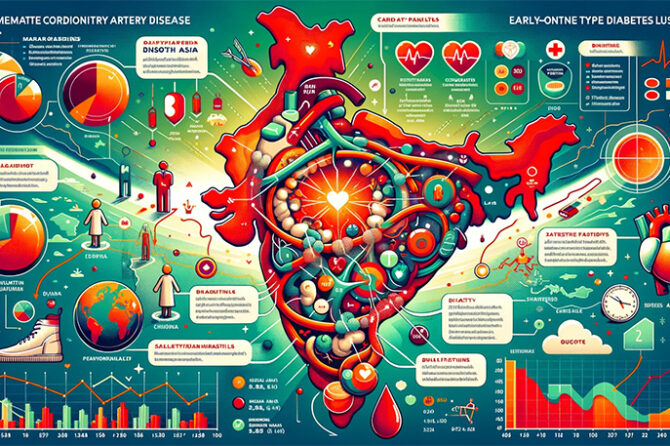
Introduction: In the insightful article “Disentangling Dual Threats: Premature Coronary Artery Disease and Early-Onset Type 2 Diabetes Mellitus in South Asians,” published in the January 2024 issue of the Journal of the Endocrine Society, authors Ranganath Muniyappa and Satish Babu K Narayanappa embark on an exhaustive exploration of two critical health challenges disproportionately affecting the South Asian population. This article, featured in Volume 8, Issue 1, of Journal of the Endocrine Society (https://doi.org/10.1210/jendso/bvad167), delves into the intricate interplay of premature coronary artery disease (CAD) and early-onset Type 2 Diabetes Mellitus (T2DM) within this demographic. Muniyappa and Narayanappa, through their comprehensive review, shed light on the alarming prevalence, underlying causes, and potential strategies for addressing these dual threats that significantly impact the health landscape of South Asians.
This detailed review addresses the critical health issues of early-onset type 2 diabetes mellitus (T2DM) and cardiovascular disease (CVD) among South Asians (SAs), particularly in India, Pakistan, and Sri Lanka. The prevalence of T2DM in this region is alarmingly high, with India alone reporting over 100 million cases of T2DM and 136 million of prediabetes. Urbanization, ethnic diversity, and socioeconomic status significantly influence these rates. A notable trend is the increasing prevalence of T2DM in rural areas and among lower socioeconomic groups. Similarly, SAs face a higher and premature risk of CVD, leading to substantial disability-adjusted life years (DALY) loss.
The review further highlights the challenges South Asian immigrants face in countries like the USA, Canada, and Europe, where they show higher T2DM prevalence compared to local populations. This is attributed to factors like obesity, sedentary lifestyles, poor diet, and environmental influences. South Asians are predisposed to develop diabetes at lower Body Mass Index (BMI) levels, and their dietary habits, especially the high consumption of refined grains, contribute to this trend. Genetic factors also play a significant role, as South Asians carry more risk alleles associated with poor β-cell function.
Premature atherosclerotic cardiovascular disease (ASCVD) is a significant concern for South Asians. They have a higher ASCVD risk compared to other groups, with Bangladesh showing the highest incidence of CVD and Pakistan the highest all-cause mortality. This risk is also evident among South Asian immigrants in the UK and the USA. Notably, cardiovascular events in South Asians occur about a decade earlier than in other populations.
The rise in CVD and T2DM in South Asia is linked to a combination of biological susceptibilities, potentially rooted in early-life epigenetic changes, and various demographic, nutritional, environmental, sociocultural, and economic factors. Hypertension, high non–high-density lipoprotein cholesterol, diabetes, obesity, and air pollution are significant contributors to the CVD burden. South Asians also exhibit higher rates of generalized and abdominal obesity and distinct lipid abnormalities.
Genetic predisposition plays a critical role in the high prevalence of CVD among South Asians, with a genome-wide polygenic risk score linked to an increased risk of coronary artery disease (CAD). The review underscores the intertwined nature of premature ASCVD and T2DM, driven by shared genetic and environmental factors.
Addressing these health challenges requires a deep understanding of the pathogenesis of both coronary artery disease and T2DM. The review emphasizes the need for targeted interventions and risk assessment strategies tailored to the unique risks faced by the South Asian population. The current lack of specific risk assessment algorithms for South Asians highlights the need for more focused research and health strategies for this group.
Comment: Ranganath Muniyappa and Satish Babu K Narayanappa’s article is a seminal work in understanding the intersecting epidemiology of premature CAD and T2DM in South Asians. Their insightful analysis not only underscores the urgency of tailored healthcare interventions but also paves the way for future research in this critical area of public health.
Prof. Dr. Prahlada N. B
06 January 2024
Yelahanka, Bengaluru.
Reference / The full article is available at the following link:
Ranganath Muniyappa, Satish Babu K Narayanappa, Disentangling Dual Threats: Premature Coronary Artery Disease and Early-Onset Type 2 Diabetes Mellitus in South Asians, Journal of the Endocrine Society, Volume 8, Issue 1, January 2024, bvad167, https://doi.org/10.1210/jendso/bvad167.

















True Prahlada Sir ,
Premature coronary artery disease( CAD ) & early onset type-2 diabetes mellitus ( T2
DM )…have become significant health challenges, particularly in Indian sub- continent, in recent times.
The causes as enumerated by you , through article by duo : Ranganath & Satish babu,
in January 2024 issue of ' Journal of endocrinology society ' are many,
& the most important one being genetic.
By addressing the following factors, I feel we can mitigate these dreaded duo , 'CAD & T2DM' to some extent…..
*Understanding the genetic factors can help in early detection & personalised management of these conditions.
*Healthy lifestyle modifications, including balanced diet, regular physical activity & weight management.
*Recognizing cultural practices & beliefs is important in promoting health education & interventions to cater to the needs of south asian community.
*Early detection of these dreaded two, CAD & T2DM, through screening programs would aid in preventing complications.
*Lastly, ensuring access to affordable & culturally sensitive healthcare services , by healthcare providers & policymakers, becomes crucial in providing timely interventions & effectively managing CAD & T2DM, in our South Asian communities.
Reply